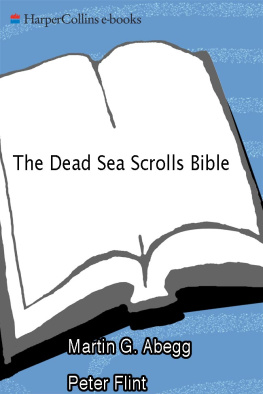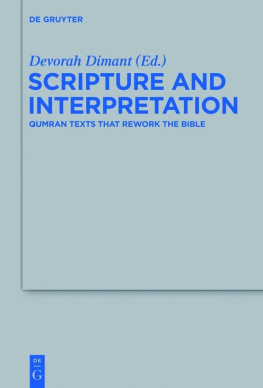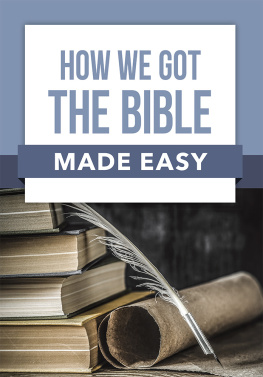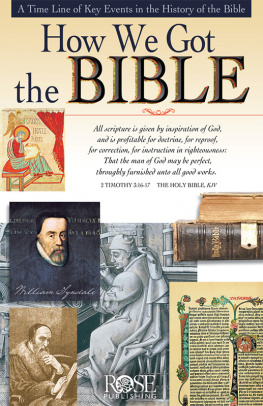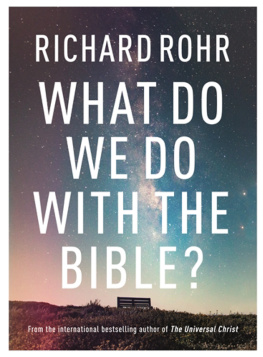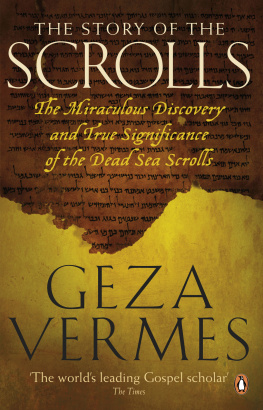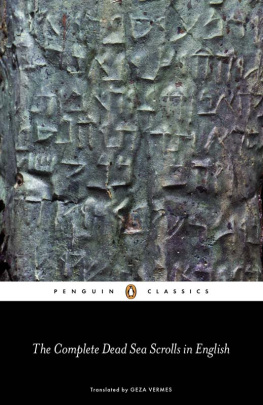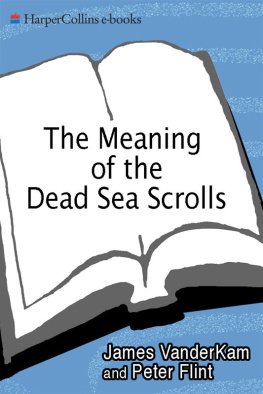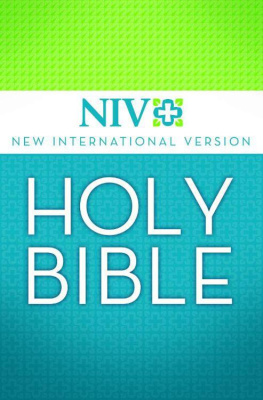
For our children: Stephanie and Jennifer
Claire, Amy, Abigail, and Jason
Sabrina, Ivan, Meg, and Laura
Contents
A t the time of Jesus and rabbi Hillelthe origins of Christianity and rabbinic Judaismthere was, and there was not, a Bible. This critical period, and the nature of the Bible in that period, have been freshly illuminated by the biblical Dead Sea Scrolls.
There was a Bible in the sense that there were certain sacred books widely recognized by Jews as foundational to their religion and supremely authoritative for religious practice. There was not, however, a Bible in the sense that the leaders of the general Jewish community had specifically considered, debated, and definitively decided the full range of which books were supremely and permanently authoritative and which onesno matter how sublime, useful, or belovedwere not. The collection or collections of the Scriptures varied from group to group and from time to time. All Jews would have recognized the Law (the Torah) and most would have recognized the Prophets as belonging to that collection. Such a recognition is attested by references in the New Testament to the Law and the Prophets (Matt 7:12; Luke 16:16; and Rom 3:21). But the exact contents of the Prophets may not have been the same for all, and the status of other books beyond the Law and the Prophets was neither clear nor widely accepted. The notion of a wider collection of Scriptures that extended beyond the Law and Prophets is suggested by an intriguing passage in Luke 24, which says that everything written about me [i.e., Jesus] in the Law of Moses, in the Prophets, and in the Psalms must be fulfilled (vs. 44).
The Dead Sea Scrolls help us see the state of affairs more clearly from an on-the-spot perspective. The Bible, or more accurately then, the Scriptures, would have been a collection of numerous separate scrolls, each containing usually only one or two books. There is indeed persuasive evidence that certain books were considered Scripture. But there is little evidence that people were seriously asking the question yet about the extent or the limits of the collectionthe crucial question for a Bible or canonwhich books are in and which books are outside this most sacred collection.
Thus, The Dead Sea Scrolls Scriptures may be a more historically accurate title for this volume. At any rate, it presents the remains of the books for which there is good evidence that Jews at that time viewed them as Sacred Scripture.
The Bibles Used Today
T he word Bible has different meanings for different people and groups. The most obvious difference in content is between the Bible of Judaism (i.e., the Hebrew Bible or Old Testament) and that of Christianity, which contains both the Old and New Testaments. The Dead Sea Scrolls Bible does not include any New Testament books for one simple reason: by the time the vast majority of the scrolls had been copied (in 68 CE ), the New Testament was only beginning to be written. Not surprisingly, then, there are no copies of New Testament books among the scrolls.
The list of books included in a Bible is termed a canon. There are three main canons in the different Bibles used today (see Figure 1):
1. The Jewish Bible (or Tanak) contains twenty-four books in three sections: the Torah, the Prophets, and the Writings.
2. The Protestant Old Testament contains the same books as the Tanak, but in four sections and in a different order: the Pentateuch, the Historical Books, the Poetical Books, and the Prophets. In addition, the Protestant canon contains thirty-nine books, not twenty-four, because it counts separately several books that comprise single books in the Jewish Bible. For example, the one Book of the Twelve Minor Prophets in the Jewish canon becomes the twelve books of the Minor Prophets in the Protestant Bible.
3. The Roman Catholic Old Testament contains exactly the same four divisions and thirty-nine books as the Protestant Bible, but also includes further writings. Seven of these are entire books (Tobit, Judith, 1 and 2 Maccabees, Wisdom of Solomon, Ecclesiasticus, and Baruch [which includes the Letter of Jeremiah]); the others are sections added to Esther (the Additions to Esther) and to Daniel (the Prayer of Azariah, Song of the Three Young Men, Susanna, and Bel and the Dragon). For Catholics, these additional writings are part of the Bible and are thus known as the deuterocanonical books (that is, a second group of canonical books). However, Jews and most Protestants do not view these writings as Scripture, labeling them the Apocrypha (plural of Apocryphon), which means hidden books.
Some scholars believe that these books are not in the Jewish and Protestant canons because they are later than most other biblical books (Daniel being an exception), while others point to their supposed secular or unorthodox content as the reason for exclusion. The real explanation, however, is more complicated and goes back to two ancient Bibles. Early Christians accepted the Greek Septuagint, which contains these additional books, as their Old Testament, while early Rabbis finalized the list of books for the Hebrew Bible in the second century CE . It is these two early collections (the shorter Hebrew one and the longer Greek one) that determine which books are included in the Bibles used by modern Jews, Protestants, and Catholics. Jews, followed by Protestants, regard the shorter collection as Scripture, whereas Catholics accept a larger canon that includes apocryphal/deuterocanonical writings found in the Septuagint.
Figure 1: Jewish, Protestant, and Roman Catholic Canons of the Old Testament

Three Old Bibles
A ll modern Bibles are translations of older texts. The Scriptures used by most readers of this book (whether Jewish, Protestant, or Roman Catholic) are based on much older manuscripts that have been translated into English. The three most important of these older Bibles are known as the Masoretic Text (MT), the Septuagint (LXX), and the Samaritan Pentateuch (SP). Scholars believe that the books in these three texts are from pre-Christian times, but unfortunately no really early manuscripts were available before the discovery of the Dead Sea Scrolls. Translations were made from the oldest available manuscripts, most of them medieval, in the belief that these late documents were accurate copies of far more ancient texts.
The Masoretic Text
Almost all modern English translations of the Old Testament are based on a single manuscript, the Leningrad Codex, which was copied in 1008 CE and is our earliest complete copy of the Masoretic (or Rabbinic) Text of the Hebrew Bible. The Leningrad Codex is used by most biblical scholars in its published edition, Biblia Hebraica Stuttgartensia (or the earlier Biblia Hebraica ).
Another important manuscript is the Aleppo Codex, which forms the basis of a new edition of the Hebrew Bible currently being produced at the Hebrew University in Jerusalem. This manuscript was copied in about 925 CE and is thus earlier than the Leningrad Codex; however, a substantial part has been lost, which means that for some books the Hebrew University project must rely on the Leningrad Codex and other Hebrew manuscripts.
Both the Leningrad Codex and the Aleppo Codex are part of what is known as the Masoretic Text. This term is quite complicated, since it covers many manuscripts rather than a single one; Masoretic Group or Masoretic Family would thus be a more accurate name. Masoretic manuscriptsincluding the Leningrad Codex and the Aleppo Codexcontain the books of the Hebrew Bible in the threefold arrangement that was developed by the Rabbis and is found in modern Jewish Bibles: the Torah, the Prophets, and the Writings (though the specific order of books sometimes varies between manuscripts).
Next page
